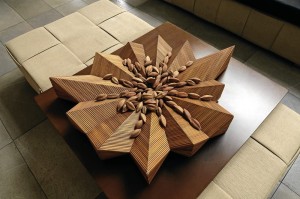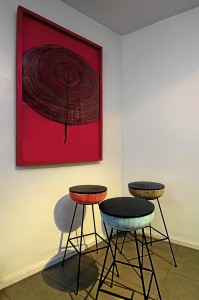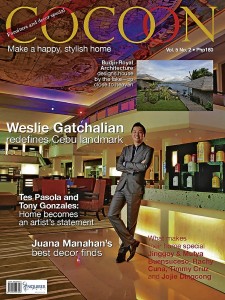
The name Tes Pasola is synonymous with paper. She believes the possibility for paper has no limits. A zen-like artwork of pulp paper can assume a biomorphic or cloud shape. Book-bound paper can be made into a stool base. A rug and curtain can be made out of twine and Swarovski crystals. A BMW model, a labyrinth or avant-garde pants and blouse can be fashioned from handmade paper. The possibilities are endless.
“I’ve made many things using handmade, industrial and recycled paper. That’s why I love paper so much. I’ve been married to it for a long time. I’ve made it flat and three-dimensional. I’m so comfortable with the material. For so long, paper has been second fiddle. I want to make it a star,” she said.
When she was married to Sofronio “Ronnie” Pasola, now deceased, their company, Mind Masters, produced stationery, boxes, paper and sculptures made from flour. While trying out new ways to make packaging, she experimented with batik on paper using wax and natural dye. Out of “batik paper,” she ended up producing boxes and stationery. In the ’80s, the company began exporting paper products.
The James Bound Collection is one of Pasola’s signature designs; it won awards for her. Handmade paper, leaves and  newspaper are die-cut, bound into books and fanned out to create an undulating effect. They become the finish for vases, stools and lighting fixtures.
newspaper are die-cut, bound into books and fanned out to create an undulating effect. They become the finish for vases, stools and lighting fixtures.
She also created paper jewelry—thick bangles using the James Bound technology—that became a powerful fashion statement.
Pasola has managed to stay practical even while experimenting. “The product designer is liable for anything that comes out of the manufacturing house. His responsibility to the consumer is to create things that must satisfy the latter’s needs without hurting his natural world, while making life worth living through what he sees. The manufacturer’s task is to make sure correct equations are met. Product designers can end up making waste products if they’re not careful.”
Concept over design
She adds, “To me, concept is more important than design. Once the concept is born, product design comes naturally. Concepts may also be derived from the need to change a manufacturer’s product line.”

One of Pasola’s most challenging works was the design of an oversized mushroom lamp for a local company. With a diameter of 2.5 meters and a height of 1.5 meters, the lamp, made of crushed capiz and pulp, seemed too big to complement a regular dining table. “Its function is to light not just the table but also the people on the sides. Right now rules dictate that the lamp should be proportionate. But there are no hard and fast rules. The bottom line is that it’s beautiful,” she stresses.
“My process in product design starts with knowing what consumers need at the present time. Now the responsibility is to create things in the ‘greenest’ way possible without compromising aesthetics. Next is to choose materials that would match the skills of our artisans. The experiment goes on, until I become confident enough to defend the product that carries my name.”
In recent years, she has been experimenting with the design of a chair made of recycled newspaper with a steel frame. The writer of a foreign magazine, for which it was being styled, asked her to keep the edges unfinished so that it would look inviting and contemporary.
A recent design that best describes Pasola is the Wading Sofa. “It’s conceptual and fun without being overdone,” she says. The slanting form makes it perfect for lounging by the poolside.

That is the commercial side to Pasola’s work.
Through the years, while doing product design, she has also been pursuing paper-based art.
For instance, for her paper-art design show, she dressed up bon vivant Peachy Prieto in a handmade paper blouse with a collar and pants with fabric lining. Instead of a guest book, Peachy was turned into a “guest person,” with people signing her clothes.
In 2005, Pasola held a joint exhibit at the Metropolitan Museum with Tony Gonzales and Impy Pilapil. She created a labyrinth that served as vestibule leading to the main exhibit area. The labyrinth was narrow and tactile so that people could brush their bodies against it.
“We studied how people would react to a wall of paper. At the end of the labyrinth, they would realize that they were embraced by paper and were ready to see the whole paper show.”
 Her wall art is a series of quiet visual poems using virgin abaca pulp transformed into clouds, spheres, grids, and interplays of positive and negative spaces done in primary colors. These were marketed in foreign trade shows and displayed in showrooms highlighted with lighting and furniture. Some art pieces were purchased in trade shows even before they could be exhibited in art galleries.
Her wall art is a series of quiet visual poems using virgin abaca pulp transformed into clouds, spheres, grids, and interplays of positive and negative spaces done in primary colors. These were marketed in foreign trade shows and displayed in showrooms highlighted with lighting and furniture. Some art pieces were purchased in trade shows even before they could be exhibited in art galleries.
“While I truly appreciate the sale, I miss the experience where you have a chance to attend a vernissage or interact with interested individuals at the opening. Moments like these make you feel like an artist.”
Aside from being an artist and product designer, Pasola has been styling for international shows such as the Manila Fame. “Through those presentations, I have helped raise the standard, and this is one significant way in which the world can learn about the Philippine brand.”









































